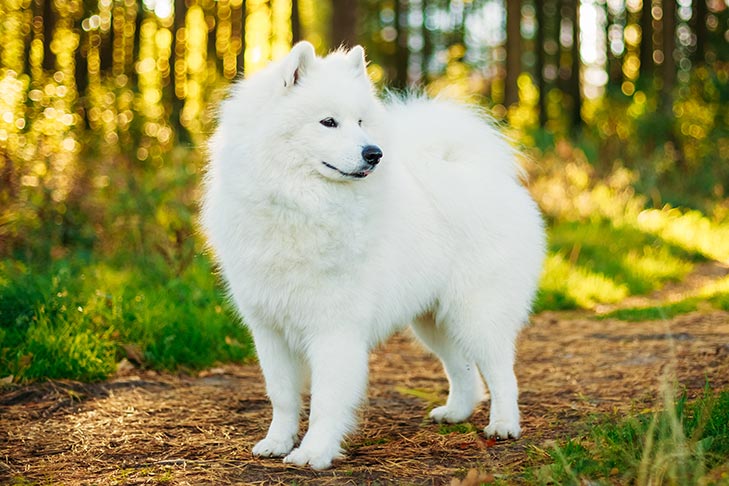
How many times have we heard comments during the heat of summer such as “Boy, your dog must really get hot”? Fortunately, Samoyeds, and Arctic breeds in general, have a number of ways of adapting to variations in temperature. The nature of a Samoyed coat (which is a double coat) makes for a very efficient insulator. Very little of the heat produced by the dog’s body is lost through contact with the cold Arctic air.
Dog Coats and Temperature Control
A Samoyed’s double layer of insulation makes perfect sense in a northern climate. But what about the Samoyed whose owners live in the southern reaches of Florida, Texas, or Arizona? In fact, Northern dog breeds are well-suited to adjust to these temperature extremes — just as they do in the Arctic, where summer temperatures can rise into the 70s.

The same insulating properties that kept them warm in the winter allow them to remain cool in the summer. Just as it’s more efficient to both heat and cool a well-insulated home, it is easier for a Northern breed to adapt to changes in temperature than a short-haired dog who may be more susceptible to heatstroke than their double-coated “cousin.”
Protecting Feet and Legs in the Cold
Despite the protection derived from a double coat, Northern breeds still face a challenge in that it is impossible to totally insulate themselves. The feet and legs (areas that come in contact with the snow) have unique properties that adapt to the cold, snowy conditions.
Instead of “shutting off” the flow of blood to the extremities — not a good thing for sled dogs — arteries that carry warm, oxygenated blood run right next to veins carrying cold, deoxygenated blood away from the limbs. Having the arteries and veins in such close proximity allows the warm blood to give heat to the cold blood, preventing the loss of heat to the exposed part of the dog’s foot.
The ability of dogs’ lower legs and feet to survive at cold temperatures isn’t well-understood. It may be that the difference in the fat between the extremities and the body is similar to that of cows. In cows, the fat found in the extremities is liquid at room temperature, whereas the tallow (the body fat) is solid. This difference in the freezing and melting point of the fats allows it to keep from becoming solid at low temperatures and becoming brittle.
Staying Cool in Hot Temperatures
Evaporation is an extremely effective method to dissipate heat. Panting is the most obvious form of evaporation used by dogs. When a dog breathes in air through their nose, the many folds of tissue in the nose increase the surface area the air has contact with. The nose also contains tissue that perspires and has a large blood flow, making it act like the radiator of a car.
In panting, a dog expels hot air through their mouth. The dog controls the amount of heat loss by controlling whether they exhale through the mouth or nose, and by how wide the mouth is opened and the position of the tongue (during panting). When a dog doesn’t want to lose heat, they merely exhale through their nose. This allows allowing more of the moisture and heat to remain in a place with a greater surface area and minimizes heat loss. This adaptation also allows dogs to compensate for changes in temperature.

It is important to remember that while people can take off layers of clothing to stay cool, dogs don’t sweat as humans do. Clipping their coats eliminates the insulating factor that helps them maintain their body temperature. Also, anything that stops a dog from expelling body heat efficiently (through panting) will keep them from being able to maintain their body temperature. This is one reason why we need to leave dogs at home rather than leave them in a locked car during the summer months.
The AKC Gazette is the official journal of the sport of purebred dogs, and hasn’t missed an issue since 1889. Read the current AKC Gazette issue, sign up to receive new issues via e-mail, and browse 10 years of back issues on AKC.org.

